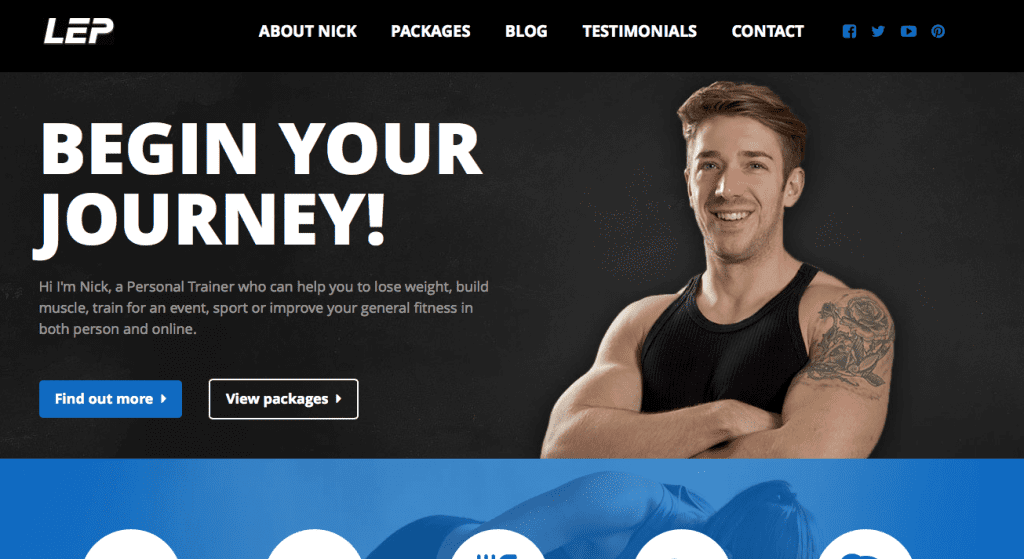The Ultimate Guide to Writing SEO-Friendly Content for Your Personal Training Website…
29/09/2019
You’ve set up your very own personal training website, but do you know about the importance of SEO?
As a fitness company or personal trainer, you’ll be very aware of just how popular your niche is online. It seems to be one of the growing trends at the moment – this means you have to stand out from the crowd.
93% of all online activity starts with a search engine – this makes it one of the most important factors to focus on, in terms of marketing. For this reason, SEO has become a crucial aspect for all companies and individuals.
Below, we’ve created a guide to writing SEO-friendly content for your fitness or personal training website.
Your actual website copy

Firstly, let’s begin with your website copy, it’s arguably the most critical part that you need to master.
There are three main components of your website copy, which you need to optimize:
- Header tags – Your H1 (main headers) and H2 (subheadings) of each page need to be optimized. The rule of thumb is to use one primary keyword in the H1, and each H2 should contain a secondary keyword.
- Copy – This is where the magic happens. Each copy should be around 700 to 1,000 words and written well. Importantly, it also has to be
- Image attributes – The Image Alt Text should never be neglected, it’s basically describing the image on your site, which helps your ranking on Google Image search results.
Don’t neglect your metadata
Metadata is so vital for all personal trainers and fitness websites, as it will profoundly improve their visibility and ranking on search engines.
Metadata consists of three- essential elements:
- The Meta title/tag – This is the title that is displayed on the search engine, which explains what the site or blog is about.
- The Meta description – This is the more detailed explanation, underneath of the meta title. It can contain details about you or the service that you offer.
- Keywords – There are primary and secondary keywords that should be used throughout the metadata.
Don’t worry, if metadata is still confusing you, we explain it in a little more detail below.
Make it short and sweet
Your metadata should be short and straight to the point – for both your title and description.
Firstly, if it has too many characters, it won’t show up on the search results properly.
Secondly, writing a concise title and description will make it easy to read, and will encourage web users to click on your site. It really is that simple.
Keywords
Of course, keywords are crucial aspects of SEO. In fact, they’re arguably the most essential part.
Keywords are the phrases in your web content that make it possible for users to find your site on search engines. Considering that SEO leads have a 14.6% close rate, you must research into keywords.
For context, outbound leads such as direct mail or print advertising only have a 1.7% close rate.
Research your keywords by using tools such as keyword finder, and plugins such as YOAST SEO.
Don’t overdo it with the SEO
Before you dive into using all the keywords you can find, remember that this can be enormously counter-productive. It’s super easy to commit the crime of “keyword stuffing.”
Overusing keywords can result in your page being automatically ranked down. Search engines will classify your website or post as using wrongful practices.
Also, adding too many keywords will make your site appear weird to the human reader. All in all, it won’t increase your chance or gaining clients or new followers.
Make sure every keyword that you choose is relevant. A great rule to follow is one keyword for the headline and primary keywords in subheadings. Anything else is just a bonus.
Location optimisation
It doesn’t matter if you’re entirely based online, local SEO is still essential for you.
Essentially, you need to target a specific geographical location, this will help you find people in your area that may just become a paying client. Of course, this is especially beneficial if you’re offering one-to-one fitness classes or PT sessions.
“Google has an excellent algorithm and design for users that search “near me” or their specific location into their search engine. For instance, if a user searches “Personal trainers near me,” you may be the first option for a potential client near you.“ — Neightan White, a writer blogger Is Accurate.
Incoming and outgoing links
Links both to other sites and your own website are essential.
For outgoing links, try to use websites that have a higher domain authority than yours. These will be well-established businesses or blogs, that can be trusted by the majority of users.
Don’t forget to link your past blog posts in your articles, as this boosts your credibility in Google’s eyes.
Try to do this yourself, without using link farms or other artificial link building techniques – this can be extremely harmful.
Create quality content

It might seem like an obvious one, but make sure that you’re creating high quality, relevant content. Make sure that people will actually want to read your blog posts, or click on the useful pages on your website.
As a personal trainer and fitness expert, you have an array of different possibilities for blog posts and other forms of content. People always want to read about new diet trends, the best workout techniques, and how to get more toned.
High-quality, informative, high-value articles that answer your target audience’s questions will rank substantially higher than those that are little random.
Don’t sleep on useful tools
Whether you’re a seasoned writer or a professional trainer that wants to spread the word to the masses, you’ll most certainly need good tools in your arsenal. There are now many online services that can help you edit and optimize your texts, in accordance to the latest SEO standards. Here are a few of them:
- Hemingway and Studicus — Popular services for editing. These tools will help you improve your writing and make it punchier and more engaging for your readers.
- Grammarly and Trust My Paper — Established proofreading and text optimization service that can help you make your texts more enticing and captivating.
- Grab My Essay and Best Essay Education — Writing services that can also consult you on SEO strategy and brand voice.
Conclusion
As a fitness website, you’re entering a competitive market. However, you’re also entering an industry which has so many opportunities to really become successful.
It’s time to get started with your SEO strategy and attract new clients that may be searching for a fitness instructor just like you.
Don’t forget, you can use tools and platforms to help with your SEO efforts, and ensure that you have more time to train and help people.
About the Author: Kristin Savage is a highly skilled writer. She works as a freelancer at BestEssayEducation & WoWGrade, Kristin also does some editing work for SupremeDissertations. And, finally… she runs her own FlyWriting blog.